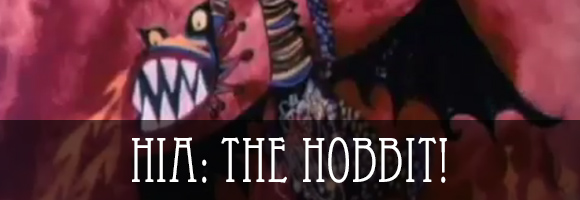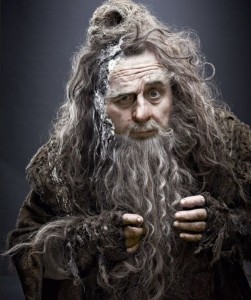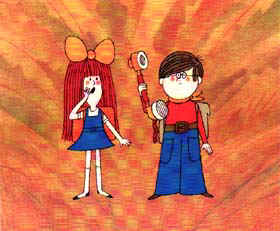Hell is Adaptations: The Hobbit!

Originally published in 1937, The Hobbit has been a perennially appealing source of material for films and other media. The book itself is an entertaining children’s story, episodic in structure, simple in tone and theme, inventively fantastic, and occasionally frightening, but generally acceptable to a broad audience. It is a widely read book, being long but never boring, and especially entertaining for its intended audience.
So obviously Peter Jackson would decide to change the tale into one of “epic” scope, filled to the brim with violent battles, portentous overtones, and car—I mean, sled—chases. But I am not yet concerned with Jackson’s ill-begotten films. His trilogy of films adapted (or perhaps “inspired”) by the novel is but the most recent example, and film rights to Tolkien’s breakout novel have been passed between studios like Hepatitis B for decades.
Once after receiving a script adapting his Lord of the Rings trilogy, Tolkien complained about the process in a letter:
I would ask them to make an effort of imagination sufficient to understand the irritation (and on occasion the resentment) of an author, who finds, increasingly as he proceeds, his work treated as it would seem carelessly in general, in places recklessly, and with no evident signs of any appreciation of what it is all about.

I cut my tobacco with the shredded remains of your script, punk.
He may very well have been thinking of the shoddy treatment given to his book by producer William L. Snyder and director Gene Deitch (Tom and Jerry, Where the Wild Things Are) with their hastily assembled eleven-minute adaptation, The Hobbit! (exclamation point included).
Fairness dictates that we give a little bit of background to this project before tearing it apart. The film rights to the entire J.R.R. Tolkien library had been purchased by Snyder, and at that time, The Hobbit was gathering a great deal of attention as the prequel to the very popular Lord of the Rings book trilogy. Snyder spend months working on a huge script that could include setup for a LOTR sequel and utilize the best animation technology of the time: “a retro visual effect, combining cel-animated figures over elaborate 3D model backgrounds,” as Deitch puts it. But when financial dealings with the studio fell through and with a deadline for a finished product looming, Snyder decided to go the easy route. In Deitch’s words:
What had happened was that in the meantime, the Tolkien craze had exploded, and the value of the film rights reached outer space. Suddenly Bill [Snyder] had the possibility of getting a hefty profit without having to finance or produce anything!
Why invest money, plus a year-and-a-half of work, when you can make money without all that sweat? Not only had the Tolkien estate lawyers given Snyder the rights for peanuts, but in their ignorance of film terminology, they had left a million-dollar-loop-hole in the contract: It merely stated that in order to hold his option for THE LORD OF THE RINGS, Snyder had to “produce a full-color motion picture version” of THE HOBBIT by June 30th 1966. Please note: It did not say it had to be an animated movie, and it did not say how long the film had to be!
The Tolkien estate had now been offered a fabulous sum for the rights, and Snyder’s rights would expire in one month. They were already rubbing their hands together. But Snyder played his ace: to fulfill just the letter of the contract – to deliver a “full-color film” of THE HOBBIT by June 30th. All he had to do was to order me to destroy my own screenplay – all my previous year’s work, and hoke up a super-condensed scenario on the order of a movie preview, (but still tell the entire basic story from beginning to end), and all within 12 minutes running time – one 35mm reel of film. Cheap. I had to get the artwork done, record voice and music, shoot it, edit it, and get it to a New York projection room on or before June 30th, 1966! I should have told him to shove it, but I was basically his slave at the time. It suddenly became an insane challenge.
Like a game of telephone… from hell.
I knew my screen story line by heart, so I just had to put it through a mind-shredder, and wrote a sort of synopsis, with a few key lines of dialog scattered throughout. I called on close friend, brilliant Czech illustrator, Adolf Born, well known even then, and now the premier book illustrator. We managed to work out a simple storyboard. Adolf came up with a paper cutout scheme, and I worked out some multiple-exposure visual effects and scene continuity. We worked directly under the camera to shoot it. I got an American friend here, Herb Lass, who worked as a broadcaster for the Czechoslovak Radio’s English language transmissions, to come up to our apartment and record the narration. I borrowed a tape of dramatic movie music from a composer friend, Václav Lidl, which I quickly extracted and cut together, also at home. It was no problem with music rights, as I could assure him that the film would never actually be distributed, but would be – sadly – a mere decoy.
What did the final product look like? Exactly like this:
Despite the obvious shortcuts taken in production, it’s surprising how coherent a narrative the short actually contains. It is certainly strange to see so many changes to the plot—the Unexpected Party now includes a love interest for Bilbo, for goodness’ sake—but quite a bit made it intact. This of course makes one wonder why Peter Jackson requires three three-hour films to tell a simple story… but I’m getting ahead of myself.
The short was shown in a small screening room to people pulled off the street, for an admission price of 10¢. Afterwards, “the few, puzzled audience members were asked to sign a paper stating that on this day of June 31, 1966, they had paid admission to see the full-color animated film, ‘THE HOBBIT!'” The film rights were thus legally extended, and by means of this blackmail, Snyder was able to sell the rights back to the Tolkien estate for the then hefty price of $100,000.
The property would eventually reappear as a full-length animated television movie in 1977. More interesting perhaps is a 1993 Finnish live action miniseries called Hobitit, which adapted elements from both The Hobbit and The Lord of the Rings. I won’t even try to describe this one, but it looks like you can watch most of it on YouTube. It’s like seeing David Lynch and Lars von Trier share a nightmare based on Der Ring des Nibelungen.
Coming Soon to a Blog Near You!: The Hobbit as animated by Rankin/Bass in 1977.



















 Full Details
Full Details




1 Comment
Wow, now that is legal sneakiness par excellance.
In reading this, I’m reminded of a chapter in a book on the films of Kurosawa by Mistuhiro Yoshimoto. Yoshimoto talks about what he calls “the discourse of adaptation” in a section on Kurosawa’s Samurai versions of Shakespeare. He writes that fidelity to the source material is always the first concern for viewers/readers, although we also have to make room for a film adaptation to make its own mark. I really came to understand this when I saw Watchmen on screen, and was talking about it with my students, one of whom said “they were so busy trying stay close to the comic that they forgot to make a good movie.” I think this student’s point and Yoshimoto’s are both very good, because they reminds us that while how close a film version stays to a book is important for fans who are looking forward to seeing what was previously only in their head on screen so that it can be shared in a new way with other people in a new experience, it still needs to distinguish itself as its own piece of art. The balance between fidelity and originality, of course, is the point of contention, and the problem is that lots of book properties that go through the Hollywood script grinder come out the other side looking the worse for wear. I think Jackson did a pretty good job with the LOTR trilogy: there were deviations sure, but I think the heart and soul of it was there. Now dividing the Hobbit into 3 movies…you’re right, it’s a simple tale and divvying it up into three parts is just fishy. Who knows what it’ll look like by movie 3? In any case, I think Tolkien would have H-A-T-E-D the movie adaptations of his books, if only because he was somewhat averse to technology and didn’t even like to be around radios. I think he might have also disliked it if he felt the films were taking the place of people reading his books.
Sorry, the comment form is closed at this time.